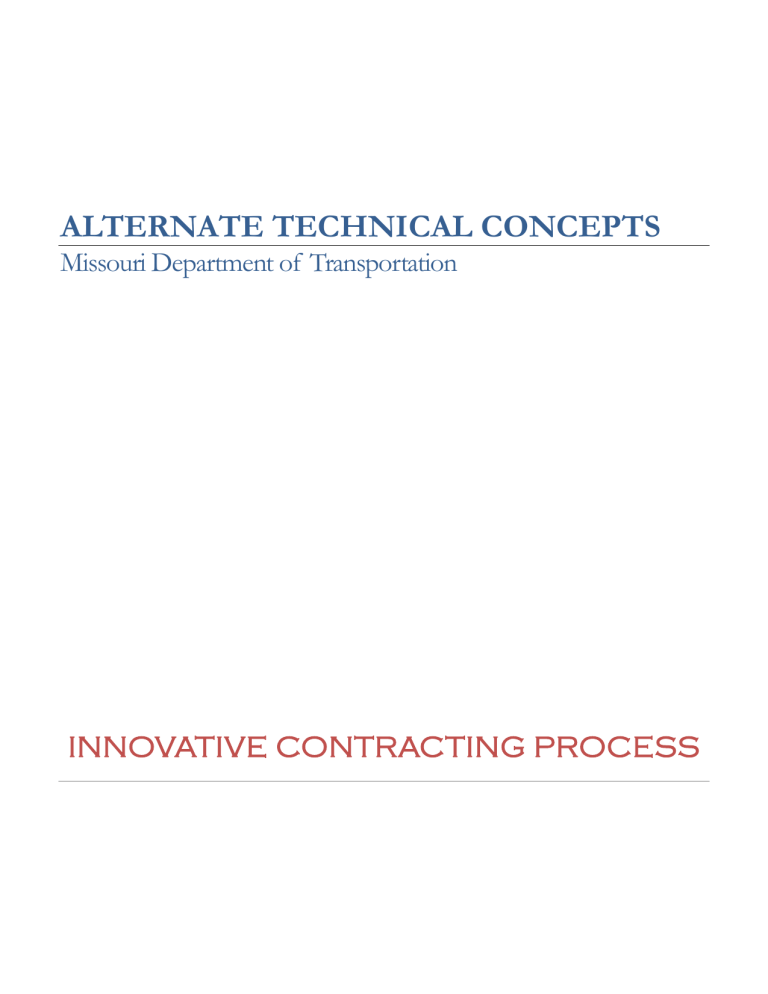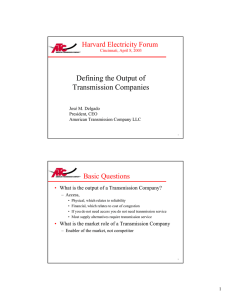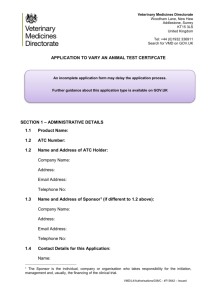ALTERNATE TECHNICAL CONCEPTS INNOVATIVE CONTRACTING PROCESS Missouri Department of Transportation

ALTERNATE TECHNICAL CONCEPTS
Missouri Department of Transportation
INNOVATIVE CONTRACTING PROCESS
Table of Contents
Introduction ...........................................................................................................
1
Description .............................................................................................
2
General Conditions .................................................................................
3
Submittal Process ...................................................................................
5
Evaluation Procedure ..............................................................................
7
Design Requirements ..............................................................................
8
Bidding Requirements .............................................................................
9
Implementation ....................................................................................
10
A L T E R N A T E T E C H N I C A L C O N C E P T S Section 1
Introduction
Collaboration
with
industry
partners
leads
to
innovative
solutions.
The Missouri Department of Transportation (MoDOT) engages transportation stakeholders to identify new ways to develop innovative contracting strategies. The feedback and collaboration we have received from industry indicates that early involvement of contractors during the bidding phase leads to the best value for our customers. Our experience shows that integration of the contractors experience and innovation during the pre-bidding process has resulted in better competition and lower bids.
The alternate bidding process is not a new process for MoDOT; in fact, we have been incrementally developing this process for over five years. In 2003, MoDOT collaborated with representatives from both the asphalt and concrete industries and FHWA to develop a process of alternate bidding structurally equivalent pavements to allow contractors the choice to bid either an asphalt or concrete pavement on construction projects. By allowing bidders this tool, MoDOT has seen a 25 percent increase in the number of bidders and cost savings of between 9-10 percent.
The successful experience with alternate bidding for pavements prompted an expansion of the alternate bidding philosophy to drainage structures (pipes/culverts) and bridge types. In 2006, MoDOT collaborated with representatives from the culvert pipe industry to allow the use of structurally equivalent corrugated metal and PVC culvert pipes as alternates to traditional reinforced concrete culvert pipe. By allowing bidders to bid alternate culvert pipes, MoDOT has seen cost savings of between 10-15 percent from the historic cost of this product.
MoDOT’s next step in the development of the innovative contracting process is the use of Alternate Technical
Concepts (ATC’s). The full ATC process utilizes value-engineering principles in the pre-bid environment. In this process, components of a project or the entire project may be open to the ATC process where contractors provide confidential feedback on design concepts to MoDOT staff. These concepts are then evaluated on a pass/fail basis. Contractors can choose to bid ATC’s that have been passed or can bid the base design that has been provided for the project. Regardless of the ATC process used on a specific project, the procurement is determined by low-bid. MoDOT began developing this process in 2007 on various components of projects including but not limited to grading, traffic control/staging and bridge construction. Upon further development, the process has been used on the entire scopes of projects. MoDOT has seen significant savings and competition on projects when this process is used.
1
A L T E R N A T E T E C H N I C A L C O N C E P T S Section 2
Description
Value
Engineering
in
the
pre
‐
bid
environment.
Alternate Technical Concepts (ATCs) are proposed changes to MoDOT supplied base design configurations. These changes provide a solution that is equal or better than the requirements of the base design. In the broadest sense, ATCs are similar to value engineering, but are made a part of the bid proposal before contract award. ATCs provide flexibility to the bidder in order to enhance innovation and achieve efficiency. The ATC process is not designed to replace the low-bid system; the standard low-bid process will be the norm, but instead it is meant to expand the flexibility of the competitive bidding process.
The framework for MoDOT’s ATC process has been developed based on lessons learned from MoDOT’s design-build projects and various NCHRP reports on innovative procurement methods. Research from the
NCHRP reports and experience from the design-build projects was used to create MoDOT’s lowest responsive bid procurement process that uses minimum technical criteria to determine pass/fail recommendations for alternate technical concept proposals.
2
A L T E R N A T E T E C H N I C A L C O N C E P T S Section 3
General Conditions
Solution
that
is
equal
or
better
than
the
requirements
of
the
base
design.
The contract proposal for all design-bid-build projects will contain all of the proposed work for the base design to be bid. Any bidder who does not wish to utilize the ATC process can, and is encouraged to bid the base design. The bidder must have the option to bid the project without submitting an ATC concept.
The ATC process is only an option for the bidder to utilize their organization’s innovative thinking at delivering the project “Better, Faster & Cheaper”.
The ATC process requires the owner, MoDOT, to define the minimum design requirements for the alternate proposals. The minimum requirements should include compliance with all state and federal laws and full compliance with all previous state and federal approval actions (i.e. NEPA, Access Justification
Reports, Design Exceptions, etc.). All previous approved actions for a project are available upon specific request to MoDOT. Any proposed ATCs requiring modifications to previously approved actions for a project (i.e., NEPA, Design Exceptions, Conceptual Reports, permits, etc.) must receive MoDOT and
FHWA approval. MoDOT in its sole discretion may reject any proposal that will require modifications to previous approvals. Any work required for modification of previously approved actions will be the responsibility of MoDOT.
The general conditions should also consider job specific design requirements for bridge and roadway including but not limited to the following:
Utility impacts
Right of Way impacts
Environmental permits
Bridge drainage
Bridge joints
Bridge approach slabs
Agreements w/ specific design MSE walls
requirements
Aesthetic enhancements
Horizontal & vertical clearances
Hydraulic design frequency
Seismic loading requirements
Scour issues
Protective coatings
Traffic control impacts
Minimum typical section
In addition to the job specific requirements, the general conditions should define the engineering standards to be used for ATC proposals. For example traffic control will be in accordance with
3
A L T E R N A T E T E C H N I C A L C O N C E P T S
MUTCD. Bidders should be encouraged to propose alternative technical requirements and additional applicable standards for the project that strive to meet or exceed the project goals. The proposed manuals, specifications and standards, shall be limited to those already reviewed by FHWA. For example, standards from other state departments of transportation are encouraged. In addition, a design exception is encouraged wherever the potential for additional value lies outside of written engineering policy. All design exceptions are subject to MoDOT’s design exception review and approval process specified in
MoDOT’s Engineering Policy Guide Sec 131.1
.
4
A L T E R N A T E T E C H N I C A L C O N C E P T S Section 4
Submittal Process
Confidentiality
creates
collaborative
team
atmosphere.
The ATC process allows prospective bidders to submit alternate technical concepts or solutions for evaluation prior to the bid opening. If the proposed ATC meets the minimum requirements and is given a “pass” recommendation the concept is considered pre-approved and may be submitted with their bid proposal.
All ATC proposals are considered confidential and will not be shared with other bidders prior to the award of the project. All members of the ATC review team will be required to sign a confidentiality agreement before reviewing any ATC submittals.
Submittal of ATC proposals is a three-step process. The first step is confidential one-on-one meetings between the contractor and ATC review team to discuss the preliminary alternate designs. If the DOT confirms the base design is complete or has advanced beyond the area of the contractor’s ATC proposal, then the ATC process proceeds to the next step. For the second step, the contractor submits a
Conceptual Alternate Technical Concept (CATC). CATCs will require minimal engineering and are intended to allow contractors to present their ideas to the ATC team in a confidential environment prior to investing time and resources into detailed engineering of their alternate proposal.
Once a CATC is approved, the contractor may choose to pursue the ATC in more detail and submit it for final approval and inclusion in the bidding documents.
Some proposals may require less design effort than others depending on the complexity of the proposal.
The ATC submittals should be focused on the critically important items of the design for early ATC approval/rejection. The contract proposal shall include an ATC submittal form that requires but is not limited to the following:
Detailed description of the proposed ATC
Detailed statement of cost savings for ATC including assumed quantities and unit prices
Statement of probable effect ATC will have on contract completion time
Description of any previous use or submittal of similar ATC or VE proposal
Certification that ATC design meets all applicable state and federal design standards
Certification that no design exceptions are required for ATC approval
Statement of potential utility conflicts, additional permits, right of way impacts or long term impacts to maintenance
5
A L T E R N A T E T E C H N I C A L C O N C E P T S
The ATC submittal should identify any specific design/construction approach the contractor intends to use for specific portions of the ATC design. For example, the bidder will define the wall systems to be used for MSE walls.
The contract proposal shall include the schedule for submittal of ATC proposals. The schedule should allow enough evaluation time to recommend a pass or fail and design an approved ATC to biddable quantities at least two weeks prior to the letting date.
6
A L T E R N A T E T E C H N I C A L C O N C E P T S Section 5
Evaluation Procedure
Evaluation
criteria
must
be
transparent
to
industry.
Alternate Technical Concepts are evaluated on a pass/fail basis. ATC proposals must meet the minimum technical criteria as defined in the general conditions. ATCs are evaluated based on clearly defined screening criteria to avoid the possibility of bid protest. The screening criteria should include but not be limited to the following:
Meets or exceeds general conditions
A proposal must produce an estimated net savings after re-design costs
Meets or exceeds minimum engineering
Does not adversely affect the cost of future improvements to the project area
Re-design costs do not adversely affect the overall cost of the project
Consistent with overall project goals standards
Does not adversely affect the overall completion date
Does not adversely affect the long term
maintenance of the project
ATC is equal to or better than base design
(defined in screening criteria)
Direct or indirect impact to utilities or right of way does not adversely the costs
ATC saves MoDOT money
The evaluation process will define the minimum time for evaluation of ATC proposals. The evaluation period should be no more than ten business days for each ATC review, and the ATC submittal process should end in enough advance time prior to the letting to allow adequate time for designing an approved
ATC to biddable quantities. A request for additional information from MoDOT should be considered a response and allowance for extension of the evaluation period. MoDOT will inform the bidder of the
ATC’s pass/fail status in writing.
All communication regarding ATC evaluation shall be documented by letter, email or in-person with minutes recorded by the contractor, and approved by MoDOT. In no way should discussions regarding specific ATC’s be discussed without written documentation, and only with approved staff.
7
A L T E R N A T E T E C H N I C A L C O N C E P T S Section 6
Design Requirements
MoDOT
is
responsible
for
the
ATC
final
re
‐
design.
The contractor will be responsible for all conceptual engineering costs that are required to develop the
CATC proposals. MoDOT will not reimburse any expenses related to the preparation of the CATC proposals.
If a CATC proposal is accepted, MoDOT will provide written approval and an estimated completion date for the re-design and the maximum cost to develop the CATC into a biddable set of plans and final redesign.
MoDOT will be responsible for all re-design costs, including design of the approved CATC to biddable quantities and the final re-design costs after award. Re-design by MoDOT ensures that all potential bidders can participate in the ATC process regardless of their design resources. This also ensures the design is being completed by a qualified approved design team and maintains the same engineer of record for the project.
MoDOT will provide the contractor a cost estimate of the re-design costs. The contractor shall include the re-design costs provided by MoDOT in their bid as a separate bid item. The re-design costs will be used to determine low bid for the basis of award; however will not be considered a part of the contract award amount. MoDOT will not be responsible for any additional re-design costs than the amount specified in the bid.
Final re-design will not proceed until the low bidder is awarded the project and has executed the contract.
The final re-design will be complete before any construction activities related to the ATC proposal can begin. The contractor will be included in review and oversight of the ATC final re-design. If necessary, weekly meetings between the design team and the contractor should be held. All communication between the contractor and design team will be written or in-person with minutes recorded. MoDOT will have final approval of design plan changes.
8
A L T E R N A T E T E C H N I C A L C O N C E P T S Section 7
Bidding Requirements
ATCs
expand
the
flexibility
of
the
low
‐
bid
competitive
bidding
process.
MoDOT will have clearly defined bid submittal requirements for any contractor that elects to bid a project with a pre-approved ATC proposal. A modified bidding document with separate job special provisions and pay items unique to the pre-approved ATC is developed in coordination with the contractor. The contractor may submit a bid for the MoDOT base design proposal or a bid that includes pricing for a pre-approved ATC. All bids are submitted electronically. Only the base bids are submitted through BidX. If the contractor elects to bid the project with pre-approved ATCs, the contractor submits the ATC bid electronically via a CD or a secure ftp site. No other contractors can view any of the bidding documents related to the ATC.
If the pre-approved ATC is abandoned or fails to be constructed by the contractor, the contractor is required to complete the project utilizing the original base design at the awarded cost and will be responsible for any final re-design cost.
9
A L T E R N A T E T E C H N I C A L C O N C E P T S Section 8
Implementation
Strategies
must
be
defined
to
expand
implementation
of
ATCs.
The framework for MoDOT’s ATC process has been developed based on lessons learned from
MoDOT’s design-build projects and various NCHRP reports on innovative procurement methods. We found the key strategies to promote the implementation of innovative procurement processes are to define legal limits, collaborate with industry, communicate results, develop training, enlist champions to promote use and use pilot projects to fine-tune practices. MoDOT has used these incremental strategies to refine the ATC process.
MoDOT’s Chief Counsel’s Office has reviewed the legal sufficiency of the ATC process and has confirmed that the process meets current state and federal laws and does not constitute a design-build project, for which
MoDOT has limited legislative authority. MoDOT’s legal staff has been an integral part of the development of this process to ensure that ATC decisions are not arbitrary or capricious and that MoDOT follows its own procurement practices.
MoDOT has engaged our industry partners by presenting the ATC concept to AGC in a variety of forums.
As we implement this process on various projects, Informational Sessions and Pre-bid Meetings are held with potential bidders to educate them on the new procurement procedures.
MoDOT continues to communicate the various innovative contracting processes at industry conferences throughout the state and country. This communication includes lessons learned from previous projects and new practices that result from those lessons. It is essential that MoDOT select the appropriate projects, provide ongoing technical support and revise procedures as appropriate to overcome recognized problems to expand implementation of these innovative contracting processes.
Training is an essential tool in the implementation of new procurement practices. MoDOT is in the early stages of developing guidelines for the use of the ATC process and this document is a step towards that goal. The best training tool is the use of this process on projects throughout the state so that multiple districts can get experience implementing this procurement process and provide additional refinement to the procedures. As more districts experience the benefits of this process, there will be more champions to promote the implementation.
10



